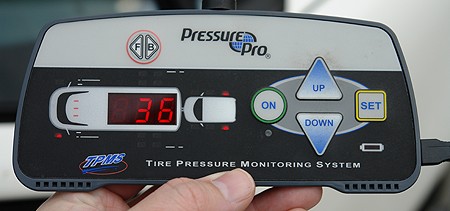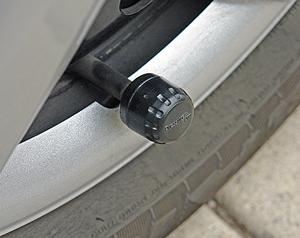The car Bibles product reviews: PressurePro TPMS.
Product Reviews
PressurePro TPMS
Tested August 2006 

I had a chance to get 'hands on' with the PressurePro system in August 2006. The system is composed of two parts - the sensors themselves and the in-vehicle reporting unit. The sensors retail for arouns $50 each and the reporting unit runs about $200 so for a regular passenger car you'd be looking at a $400 shell-out. PressurePro sell mainly to the trucking and RV markets right now, and the unit I had to test was, as you can see from the photos, an RV unit. PressurePro have struck deals with a couple of RV manufacturers who are equipping their vehicles with the PressurePro system and connecting it to the RV central display / monitoring device via RS232 connections. The sensors themselves are quite large and weigh in at about 14 grams. If you were going to fit these to your vehicle, I'd recommend you get your wheels and tyres balanced afterwards just to be safe. With the system powered on, the display initially reads "No Sensor" for each position on the vehicle. In my test, the unit was an RV system and capable of monitoring 16 tyres. I set it up so the front two sensors were set as the front two wheels on the RV, and the rear two were set up as the trailing tyres on the towed vehicle. Using the up and down arrow keys, you select the appropriate position for the sensor you're going to install, and screw the sensor on to the valve stem. After about 4 seconds, the display changes from "No sensor" to a numerical display of the tyre pressure. That becomes the baseline pressure for that sensor. It will trip warning when the pressure drops 12.5% below the baseline, and again at 25% below the baseline. Setting up the sensors and the in-car unit was a snap and for the test, my vehicle was a rental car. As it happened, within 6 miles of leaving the rental counter, the PressurePro system beeped and the right-front LED started flashing on the display unit. It turns out the rubber in the valve stem had perished and was leaking and the sensor detected the drop in tyre pressure and alerted me, exactly as it should. Frankly it was a far better test than I'd been planning. My idea had been to drive around for a while, the stop and unscrew a sensor, thus giving it a zero reading. I did this anyway, and it took around 4 second from unscrewing the sensor to the in-car unit alerting me to a problem and flashing "00" on the display. That seems like a long time in a static test, but in reality, it's no time at all if you're driving. The car version of the display unit looks similar to the RV version I had to test only it doesn't have the RV graphic on it, and the F/B button is missing. On the RV versions, that button can be used to temporarily disable the readings from either the front or back vehicle. For example if you were to unhitch the towed vehicle, you'd only want the unit to look for readings from the front vehicle. If you didn't, when you got more than a couple of metres away, all four readings from the towed vehicle would error with zero readings because they'd be out of range. Speaking of 'out of range', the little aerial on the top of the display unit can be removed and replaced with a 35ft coax extension with another aerial at the far end. For particularly long RVs or trailers, this allows you to place the receiver antenna further back along the vehicle to ensure a strong signal from all sensors.

So what do I make of this system? Well from model year 2007 onwards, all SUV and truck class vehicles in America must have a tyre pressure alerting system. These systems must alert the driver when any tyre drops 25% below its target pressure. The systems can be as simple as a flashing "there's something wrong" light up to elaborate systems like the PressurePro which show the tyre in question and give you a pressure reading. So my take on it is this; if you're buying a new vehicle and it comes with one of these systems, you can probably pass. But if you've already got a vehicle and you want an aftermarket system, this seems as good as any. The nice thing is it requires no technical knowledge or electrical or bodywork modifications to fit. It ultimately comes down to two things : relative cost, and percieved safety. $400 for a system like this on a passenger vehicle might seem expensive compared to the cost of fitting out a $100,000 RV with the same system. But as Ford proved with the exploding tyres problem on their Explorer, your perceived safety will evaporate very quickly when a tyre blows out at speed. As a plus, because of the design of the PressurePro, it is 100% portable - you can take it from vehicle to vehicle so it could easily be a one-time expense that you can take with you as you go through your vehicles.
Is it worth $400 to you to fit a system like this before you get into trouble? Or do you want to take it in the bank account in the event of an accident? The PressurePro system, like all TPMS systems, is ultimately like car insurance. It's a pain in the arse to pay for it up front because you might never need it. But if you have an accident and don't have insurance, then $400 seems really cheap in comparison. If you're strict with yourself and check your pressures regularly, then you probably don't really need a TPMS system. But as with so many products, here they're catering for human frailty, because in reality, how many drivers (who aren't car nuts) ever check their tyre pressures?

